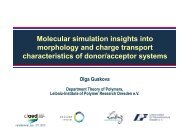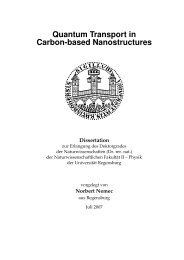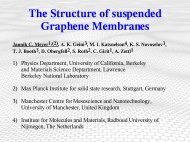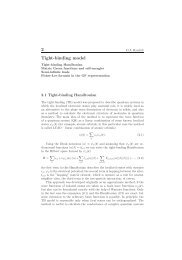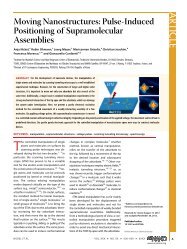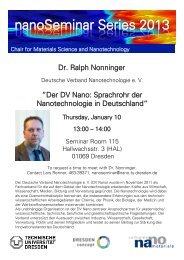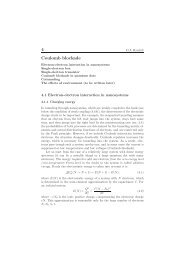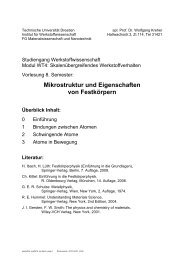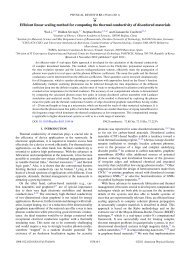Novel Boron(-Carbon) - Chair of Materials Science and ...
Novel Boron(-Carbon) - Chair of Materials Science and ...
Novel Boron(-Carbon) - Chair of Materials Science and ...
Create successful ePaper yourself
Turn your PDF publications into a flip-book with our unique Google optimized e-Paper software.
<strong>Novel</strong> <strong>Boron</strong>(-<strong>Carbon</strong>) Nanomaterials: Structure, Properties <strong>and</strong> Applications<br />
Institut für Werkst<strong>of</strong>fwissenschaft, TU Dresden, April 2009 © Alex Qu<strong>and</strong>t, Universität Greifswald (D)<br />
<strong>Novel</strong> <strong>Boron</strong>(-<strong>Carbon</strong>)<br />
Nanomaterials:<br />
Structure, Properties <strong>and</strong><br />
Applications<br />
Alex<strong>and</strong>er Qu<strong>and</strong>t,<br />
Institut für Physik, U. Greifswald (D)
<strong>Novel</strong> <strong>Boron</strong>(-<strong>Carbon</strong>) Nanomaterials: Structure, Properties <strong>and</strong> Applications<br />
Institut für Werkst<strong>of</strong>fwissenschaft, TU Dresden, April 2009 © Alex Qu<strong>and</strong>t, Universität Greifswald (D)<br />
„New ideas pass through three periods:<br />
1.It can‘t be done.<br />
2.It probably can be done, but it‘s not worth doing.<br />
3.I knew it was a good idea all along“.<br />
(Arthur C. Clarke)
<strong>Novel</strong> <strong>Boron</strong>(-<strong>Carbon</strong>) Nanomaterials: Structure, Properties <strong>and</strong> Applications<br />
Institut für Werkst<strong>of</strong>fwissenschaft, TU Dresden, April 2009 © Alex Qu<strong>and</strong>t, Universität Greifswald (D)<br />
Survey <strong>of</strong> this talk :<br />
Composite<br />
Nanomaterials<br />
Nanoelectronics<br />
Nanomedicine
<strong>Carbon</strong><br />
Nanomaterials<br />
(CNTs, Graphene)<br />
<strong>Novel</strong> <strong>Boron</strong>(-<strong>Carbon</strong>) Nanomaterials: Structure, Properties <strong>and</strong> Applications<br />
Institut für Werkst<strong>of</strong>fwissenschaft, TU Dresden, April 2009 © Alex Qu<strong>and</strong>t, Universität Greifswald (D)<br />
<strong>Materials</strong><br />
PACS 61.48.De<br />
Structure <strong>of</strong> carbon<br />
nanotubes, boron<br />
nanotubes, <strong>and</strong><br />
related graphitelike<br />
systems.<br />
(for structure <strong>of</strong><br />
hollow nanowires,<br />
see 61.46.Np)<br />
<strong>Boron</strong><br />
Nanomaterials<br />
(Clusters, BNTs, Sheets)
<strong>Novel</strong> <strong>Boron</strong>(-<strong>Carbon</strong>) Nanomaterials: Structure, Properties <strong>and</strong> Applications<br />
Institut für Werkst<strong>of</strong>fwissenschaft, TU Dresden, April 2009 © Alex Qu<strong>and</strong>t, Universität Greifswald (D)<br />
<strong>Carbon</strong>
<strong>Novel</strong> <strong>Boron</strong>(-<strong>Carbon</strong>) Nanomaterials: Structure, Properties <strong>and</strong> Applications<br />
Institut für Werkst<strong>of</strong>fwissenschaft, TU Dresden, April 2009 © Alex Qu<strong>and</strong>t, Universität Greifswald (D)<br />
• Graphite <strong>and</strong> diamond :<br />
Graphite (P6 3/mmc, hexagonal)<br />
Cohesive energy : 7.4 eV/atom (sp 2 )<br />
B<strong>and</strong> gap : -0.04 eV (semimetal)<br />
Hardness : 0.5 9<br />
• Fullerenes <strong>and</strong> nanotubes :<br />
C60-molecule<br />
<strong>Carbon</strong> chemistry<br />
Discovered in 1985<br />
(Curl, Kroto,<br />
Smalley)<br />
Nobel Prize<br />
Chemistry 1996<br />
Diamond (Fd3m, cubic)<br />
Cohesive energy : 7.2 eV/atom (sp 3 )<br />
B<strong>and</strong> gap : 5.47 eV (insulator)<br />
Hardness : 10<br />
<strong>Carbon</strong> nanotube<br />
Discovered in<br />
1991 (Iijima)
<strong>Novel</strong> <strong>Boron</strong>(-<strong>Carbon</strong>) Nanomaterials: Structure, Properties <strong>and</strong> Applications<br />
Institut für Werkst<strong>of</strong>fwissenschaft, TU Dresden, April 2009 © Alex Qu<strong>and</strong>t, Universität Greifswald (D)<br />
<strong>Carbon</strong> clusters<br />
See: R. O. Jones, J. Chem. Phys. 110, 5189 (1999); R. O. Jones & G. Seifert, PRL 79, 443 (1997).<br />
C 4-C 10: Chains, rings. C 18: Cages, rings. C 32: Cages, graphitic.<br />
Slow transition : chains, rings, cages, graphitic ….
• Old idea:<br />
<strong>Novel</strong> <strong>Boron</strong>(-<strong>Carbon</strong>) Nanomaterials: Structure, Properties <strong>and</strong> Applications<br />
Institut für Werkst<strong>of</strong>fwissenschaft, TU Dresden, April 2009 © Alex Qu<strong>and</strong>t, Universität Greifswald (D)<br />
Graphene (K. S. Novoselov, <strong>Science</strong> 306, 666 (2004))<br />
Isolate a single layer <strong>of</strong> graphene !<br />
• Solution:<br />
Starting from graphite, peel <strong>of</strong>f<br />
layers one by one using adhesive<br />
tape until one layer is left.<br />
Multi-layered graphene<br />
Dimer<br />
Border <strong>of</strong> armchair nanoribbons<br />
a2<br />
a1<br />
Border <strong>of</strong> zigzag nanoribbons<br />
Graphene sheet/nanoribbons
<strong>Novel</strong> <strong>Boron</strong>(-<strong>Carbon</strong>) Nanomaterials: Structure, Properties <strong>and</strong> Applications<br />
Institut für Werkst<strong>of</strong>fwissenschaft, TU Dresden, April 2009 © Alex Qu<strong>and</strong>t, Universität Greifswald (D)<br />
• Cut & Paste :<br />
Cut a rectangular sheet<br />
(n,m) out <strong>of</strong> bulk graphene,<br />
paste it, <strong>and</strong> attach similar<br />
segments periodically.<br />
• Electronic properties :<br />
<strong>Carbon</strong> nanotubes<br />
(4,2)<br />
(6,0)<br />
Electronic properties depend on the chirality <strong>of</strong> the tubes, on<br />
mechanical deformations etc. Hard to control experimentally !<br />
CNT-forest<br />
DOS <strong>of</strong> (6,6)-nanotube
<strong>Novel</strong> <strong>Boron</strong>(-<strong>Carbon</strong>) Nanomaterials: Structure, Properties <strong>and</strong> Applications<br />
Institut für Werkst<strong>of</strong>fwissenschaft, TU Dresden, April 2009 © Alex Qu<strong>and</strong>t, Universität Greifswald (D)<br />
Composite Nanomaterials<br />
<strong>Boron</strong> doped<br />
multiwalled carbon<br />
B nanotubes<br />
C
<strong>Novel</strong> <strong>Boron</strong>(-<strong>Carbon</strong>) Nanomaterials: Structure, Properties <strong>and</strong> Applications<br />
Institut für Werkst<strong>of</strong>fwissenschaft, TU Dresden, April 2009 © Alex Qu<strong>and</strong>t, Universität Greifswald (D)<br />
Electron deficient (ED) elements<br />
• ED element has more stable orbitals than electrons in its valence shell.<br />
• Characteristics :<br />
1. Ligancy <strong>of</strong> ED atom higher than the<br />
number <strong>of</strong> valence electrons, <strong>and</strong> even<br />
higher than the number <strong>of</strong> stable<br />
orbitals.<br />
2. ED atom causes adjacent atoms to<br />
increase ligancy to value greater than<br />
the orbital number.<br />
See: L. Pauling, Nature <strong>of</strong> the Chemical Bond.<br />
Aromatic BC clusters with<br />
hypercoordinated carbon :<br />
Wang & Schleyer, <strong>Science</strong> 292, 2465<br />
(2001).<br />
Exner & Schleyer, <strong>Science</strong> 290, 1937<br />
(2000).
<strong>Novel</strong> <strong>Boron</strong>(-<strong>Carbon</strong>) Nanomaterials: Structure, Properties <strong>and</strong> Applications<br />
Institut für Werkst<strong>of</strong>fwissenschaft, TU Dresden, April 2009 © Alex Qu<strong>and</strong>t, Universität Greifswald (D)<br />
<strong>Boron</strong> Sheets <strong>and</strong> <strong>Boron</strong> Nanotubes<br />
puckered tube<br />
triangular<br />
lattice<br />
unit cell<br />
Stable planar boron<br />
sheets <strong>and</strong> tubular<br />
boron clusters obtained<br />
from pyramidal B 7<br />
subunits.<br />
<strong>Boron</strong> nanotubes <strong>and</strong><br />
boron sheets should<br />
always be metallic !
<strong>Novel</strong> <strong>Boron</strong>(-<strong>Carbon</strong>) Nanomaterials: Structure, Properties <strong>and</strong> Applications<br />
Institut für Werkst<strong>of</strong>fwissenschaft, TU Dresden, April 2009 © Alex Qu<strong>and</strong>t, Universität Greifswald (D)<br />
• Basic questions :<br />
Compatibility <strong>of</strong> different<br />
nanotubular systems ?<br />
Structural paradigm for<br />
nanojunctions, interfaces,<br />
sublithographic patterning<br />
…..<br />
• Model junctions :<br />
Local chemistry <strong>of</strong> stable junctions.<br />
Nanotubular heterojunctions<br />
Unit cell <strong>of</strong> BC bundle<br />
<strong>Boron</strong><br />
<strong>Carbon</strong><br />
DOS <strong>of</strong> BC-heterojunction<br />
(J. Kunstmann <strong>and</strong> A. Qu<strong>and</strong>t, J. Chem. Phys. 121, 10680 (2004))
<strong>Novel</strong> <strong>Boron</strong>(-<strong>Carbon</strong>) Nanomaterials: Structure, Properties <strong>and</strong> Applications<br />
Institut für Werkst<strong>of</strong>fwissenschaft, TU Dresden, April 2009 © Alex Qu<strong>and</strong>t, Universität Greifswald (D)<br />
Structure control/Layout<br />
(J. Kunstmann, A. Qu<strong>and</strong>t, I. Boustani, Nanotechnology 18, 155703 (2007))<br />
zigzag BNT armchair BNT<br />
Strain energy <strong>of</strong> CNTS depends on radius.<br />
Strain energy <strong>of</strong> BNTs depends on radius <strong>and</strong> chiral angle !<br />
Thus : use short segments <strong>of</strong> BNTs to grow specific CNTS.
<strong>Novel</strong> <strong>Boron</strong>(-<strong>Carbon</strong>) Nanomaterials: Structure, Properties <strong>and</strong> Applications<br />
Institut für Werkst<strong>of</strong>fwissenschaft, TU Dresden, April 2009 © Alex Qu<strong>and</strong>t, Universität Greifswald (D)<br />
• Structure (AlB 2) :<br />
B : honeycomb lattice<br />
Al : center <strong>of</strong> hexagons,<br />
between boron sheets<br />
• Properties :<br />
Metal-boron nanotubes<br />
puckered AlB 2-sheet, reference structure<br />
for at least 22 compounds <strong>of</strong> type MeB 2,<br />
comprising sp-, d-, <strong>and</strong> f-metals Me.<br />
Theory : A. Qu<strong>and</strong>t, A. Y. Liu <strong>and</strong> I. Boustani, PRB 64, 125422 (2001).<br />
•Twisted in a gearlike<br />
fashion.<br />
• small 0.23 eV/atom<br />
instability w.r.t.<br />
crystalline AlB 2<br />
(0.14 eV/atom for (6,6)<br />
carbon nanotube !)<br />
(6,6) nanotube<br />
• metallic.<br />
unit cell <strong>of</strong> (6,6) nanotube bundle DOS <strong>of</strong> (6,6) nanotube
<strong>Novel</strong> <strong>Boron</strong>(-<strong>Carbon</strong>) Nanomaterials: Structure, Properties <strong>and</strong> Applications<br />
Institut für Werkst<strong>of</strong>fwissenschaft, TU Dresden, April 2009 © Alex Qu<strong>and</strong>t, Universität Greifswald (D)<br />
Other composites
<strong>Novel</strong> <strong>Boron</strong>(-<strong>Carbon</strong>) Nanomaterials: Structure, Properties <strong>and</strong> Applications<br />
Institut für Werkst<strong>of</strong>fwissenschaft, TU Dresden, April 2009 © Alex Qu<strong>and</strong>t, Universität Greifswald (D)<br />
Nanotube composites<br />
„Nanophase materials – metals or ceramics with very small grain sizes – have been<br />
fairly disappointing.“<br />
• small grains should result in harder metals. They turn out to be harder, but also<br />
more brittle.<br />
• ceramics with very small grains would be much stronger, which has not really been<br />
demonstrated, yet.<br />
„…. Yet there is reason to expect that nanometre-scale composite materials might<br />
turn out to be better than conventional composites“.<br />
Paul Calvert, A recipe for strength, Nature 399, 210 (1999).<br />
• The idea:<br />
• s<strong>of</strong>t matrix (polymer) + stiff, load bearing filler (fiber).<br />
• search for fibers with high aspect ratio (length to width)<br />
→ nanotubes (aspect ratios <strong>of</strong> 1000 or more).<br />
• fibers may add new properties to polymer matrix, like<br />
thermal <strong>and</strong> electrical conductivity.<br />
see: P. M. Ajayan <strong>and</strong> J. Tour, Nanotube composites, Nature 447, 1066 (2007)
<strong>Novel</strong> <strong>Boron</strong>(-<strong>Carbon</strong>) Nanomaterials: Structure, Properties <strong>and</strong> Applications<br />
Institut für Werkst<strong>of</strong>fwissenschaft, TU Dresden, April 2009 © Alex Qu<strong>and</strong>t, Universität Greifswald (D)<br />
Three roads to bind CNTs inside a polymer matrix.<br />
Major problems: create strong but flexible bonds,<br />
bundles must be broken to disperse individual<br />
CNTs.<br />
Examine BNT-polymer<br />
composites <strong>and</strong> B(-C)NTpolymer<br />
composites !<br />
Problems & Solutions<br />
<strong>Boron</strong> nanotubes are:<br />
a) Always metallic.<br />
Typical problems:<br />
1. Pull out <strong>of</strong> single<br />
CNTs, f.e. during<br />
fracture.<br />
2. Percolation: In<br />
order to achieve<br />
conductivity, it is<br />
necessary to<br />
create a network<br />
<strong>of</strong> conducting<br />
CNTs.<br />
b) Mechanically strong (armchair) .<br />
c) Show strong, but flexible type <strong>of</strong><br />
bonding. More suitable for polymers.<br />
See: Kunstmann & Qu<strong>and</strong>t, Phys. Rev. B 74, 035413<br />
(2006).
<strong>Novel</strong> <strong>Boron</strong>(-<strong>Carbon</strong>) Nanomaterials: Structure, Properties <strong>and</strong> Applications<br />
Institut für Werkst<strong>of</strong>fwissenschaft, TU Dresden, April 2009 © Alex Qu<strong>and</strong>t, Universität Greifswald (D)<br />
Nano-Electronics
<strong>Novel</strong> <strong>Boron</strong>(-<strong>Carbon</strong>) Nanomaterials: Structure, Properties <strong>and</strong> Applications<br />
Institut für Werkst<strong>of</strong>fwissenschaft, TU Dresden, April 2009 © Alex Qu<strong>and</strong>t, Universität Greifswald (D)<br />
gate insulator<br />
source gate<br />
drain<br />
substrate<br />
MOSFETs & TubFETs<br />
A. Qu<strong>and</strong>t, M. Ferrari, G. Righini, Towards Integrated Nanoelectronic <strong>and</strong> Photonic Devices, in press (2009).<br />
• Basic layout:<br />
• FET design problems:<br />
source gate<br />
substrate<br />
MOSFET TubFET<br />
insulating layers<br />
drain<br />
Smaller gate length ↔ increase doping to switch <strong>of</strong>f the device.<br />
Higher mobility ↔ straining <strong>of</strong> substrate.<br />
Higher gate voltage ↔ leakage currents, large power consumption.
<strong>Novel</strong> <strong>Boron</strong>(-<strong>Carbon</strong>) Nanomaterials: Structure, Properties <strong>and</strong> Applications<br />
Institut für Werkst<strong>of</strong>fwissenschaft, TU Dresden, April 2009 © Alex Qu<strong>and</strong>t, Universität Greifswald (D)<br />
• Advantages/disadvantages <strong>of</strong> CNT channels:<br />
Pro:<br />
• small (1-2 nm) <strong>and</strong> atomically smooth.<br />
• very high carrier mobilities.<br />
• small gate voltage.<br />
• low channel capacitance.<br />
• tunable gap (~1/diameter).<br />
See: P. Avouris, Physics Today 62, 34 (2009).<br />
• B<strong>and</strong>width problems:<br />
• Challenges:<br />
Con:<br />
• problematic layout: mixtures <strong>of</strong><br />
metallic/semiconducting CNTs.<br />
• disturbing Schottky barriers between<br />
CNTs <strong>and</strong> metallic contacts.<br />
Solution: Employ BNTs !!!<br />
(~ structure control, junctions)<br />
1. Develop reliable FET technology (substrates, channels, wires …)<br />
below 42 nm gate length (state <strong>of</strong> the art).<br />
2. Supply fast <strong>and</strong> integrated global interconnects.
<strong>Novel</strong> <strong>Boron</strong>(-<strong>Carbon</strong>) Nanomaterials: Structure, Properties <strong>and</strong> Applications<br />
Institut für Werkst<strong>of</strong>fwissenschaft, TU Dresden, April 2009 © Alex Qu<strong>and</strong>t, Universität Greifswald (D)<br />
Graphene nanoribbons<br />
A. Qu<strong>and</strong>t, C. Özdogan, J. Kunstmann, H. Fehske, Nanotechnology 19, 335707 (2008).<br />
• Electronic properties <strong>of</strong> graphene nanoribbons (TB theory):<br />
All zigzag nanoribbons are metallic.<br />
Armchair nanoribbons are either metallic or semiconducting,<br />
depending on the number <strong>of</strong> dimers across the width <strong>of</strong> the ribbons.<br />
• Examples (DFT):<br />
Armchair graphene nanoribbon<br />
Zigzag graphene nanoribbon
<strong>Novel</strong> <strong>Boron</strong>(-<strong>Carbon</strong>) Nanomaterials: Structure, Properties <strong>and</strong> Applications<br />
Institut für Werkst<strong>of</strong>fwissenschaft, TU Dresden, April 2009 © Alex Qu<strong>and</strong>t, Universität Greifswald (D)<br />
Armchair graphene nanoribbon<br />
Functionalizing graphene<br />
Nanowires <strong>and</strong> devices at the ultimate size limit <strong>of</strong> nanotechnology ?<br />
• Insert alternating chains <strong>of</strong> boron clusters :<br />
B 7 doped armchair nanoribbon<br />
See: A. Qu<strong>and</strong>t, C. Özdogan, J. Kunstmann, H. Fehske, Nanotechnology 19, 335707 (2008).
<strong>Novel</strong> <strong>Boron</strong>(-<strong>Carbon</strong>) Nanomaterials: Structure, Properties <strong>and</strong> Applications<br />
Institut für Werkst<strong>of</strong>fwissenschaft, TU Dresden, April 2009 © Alex Qu<strong>and</strong>t, Universität Greifswald (D)<br />
Diverging technologies ?<br />
• Top down design for integrated devices using lithographic techniques:<br />
Electronics:<br />
Rayleigh limit:<br />
Photonics:<br />
Electron currents, wavelength within Å range. Photon streams, 850/1300/1550 nm wavelength.<br />
Processors: 42 nm technologies <strong>and</strong> smaller using<br />
extreme UV lithographic techniques.<br />
Integrated optical devices should be large enough to<br />
interact with technical (IR) photon streams (>850 nm).
<strong>Novel</strong> <strong>Boron</strong>(-<strong>Carbon</strong>) Nanomaterials: Structure, Properties <strong>and</strong> Applications<br />
Institut für Werkst<strong>of</strong>fwissenschaft, TU Dresden, April 2009 © Alex Qu<strong>and</strong>t, Universität Greifswald (D)<br />
Lycurgus cup (400 AD).<br />
Plasmonics<br />
Surface plasmon-polaritons (SPP) are TM light<br />
waves trapped on dielectric/metal interfaces, due to<br />
interaction with free electrons <strong>of</strong> the conductor.<br />
For a review see: Barnes et. al., Nature 424, 824 (2003), or: Maier & Atwater, J. Appl. Phys. 98, 011101 (2005).
<strong>Novel</strong> <strong>Boron</strong>(-<strong>Carbon</strong>) Nanomaterials: Structure, Properties <strong>and</strong> Applications<br />
Institut für Werkst<strong>of</strong>fwissenschaft, TU Dresden, April 2009 © Alex Qu<strong>and</strong>t, Universität Greifswald (D)<br />
Photon-STM picture <strong>of</strong> surface plasmon-polariton<br />
wave (SPP) scattered at surface Bragg grating.<br />
From: Zia et. al., <strong>Materials</strong> Today 9, 20 (2006).<br />
How to generate an SPP …<br />
Theory (see: Meyer & Atwater …)<br />
predicts longer propagation<br />
lengths for certain SPP modes in<br />
extremely thin metallic films.<br />
Determine ε(ω) for free st<strong>and</strong>ing or<br />
suspendend B(-C) nanomaterials (ab<br />
initio).<br />
Afterwards, it will be sufficient to use<br />
classical electrodynamics in order to<br />
design suitable plasmonic devices.<br />
Eberlein et. al., Plasmon Spectroscopy <strong>of</strong> Free St<strong>and</strong>ing Graphene Films, PRB 77, 233406 (2009):<br />
Red shift <strong>of</strong> in-plane π →π* plasmon peaks <strong>of</strong> bulk graphite towards the visible range (4.7 eV)!
<strong>Novel</strong> <strong>Boron</strong>(-<strong>Carbon</strong>) Nanomaterials: Structure, Properties <strong>and</strong> Applications<br />
Institut für Werkst<strong>of</strong>fwissenschaft, TU Dresden, April 2009 © Alex Qu<strong>and</strong>t, Universität Greifswald (D)<br />
<strong>Novel</strong> concepts & layout strategies<br />
• <strong>Novel</strong> graphene based nano-electronics :<br />
Bulky concepts<br />
cluster<br />
source<br />
boron cluster<br />
doped graphene layer<br />
boron clusters<br />
Semicond. graphene nanoribbon<br />
Integrated electronic devices<br />
Use existing technologies:<br />
• Implantation <strong>of</strong> boron clusters is st<strong>and</strong>ard procedure<br />
for silicon based integrated circuits ( ~42 nm).<br />
• First step: put graphite into the same machines!<br />
Metallic graphene<br />
nanoribbon<br />
Refractive/plasmonic<br />
elements<br />
• Peel <strong>of</strong>f single boron doped layers the st<strong>and</strong>ard way<br />
<strong>and</strong> analyze them.<br />
• Depending on intensity <strong>of</strong> cluster beam, neighboring<br />
layers may contain copies <strong>of</strong> roughly the same pattern.<br />
• Gradual improvements : speckle patterns <strong>of</strong> large<br />
boron isl<strong>and</strong>s, dotted lines, dotted devices, ….
<strong>Novel</strong> <strong>Boron</strong>(-<strong>Carbon</strong>) Nanomaterials: Structure, Properties <strong>and</strong> Applications<br />
Institut für Werkst<strong>of</strong>fwissenschaft, TU Dresden, April 2009 © Alex Qu<strong>and</strong>t, Universität Greifswald (D)<br />
Nanomedicine
<strong>Novel</strong> <strong>Boron</strong>(-<strong>Carbon</strong>) Nanomaterials: Structure, Properties <strong>and</strong> Applications<br />
Institut für Werkst<strong>of</strong>fwissenschaft, TU Dresden, April 2009 © Alex Qu<strong>and</strong>t, Universität Greifswald (D)<br />
• Tasks <strong>and</strong> examples:<br />
What is Nanomedicine ?<br />
„Nanomedicine can be defined as the monitoring, repairing, construction <strong>and</strong> control<br />
<strong>of</strong> human biological systems at the cellular level by using materials <strong>and</strong> structures<br />
engineered at the molecular level.“<br />
M. Kralj & K. Pavelic, EMBO reports 4, 1008 (2003).<br />
1. Drug delivery: liposomes, polymer nanoparticles,<br />
nanosuspensions (accelerated distribution).<br />
2. Drugs <strong>and</strong> therapy: fullerenes <strong>and</strong> dendrimers<br />
(unique medical effects due to structure).<br />
3. In Vivo imaging: contrast agents like<br />
superparamagnetic iron oxide nanoparticles for MRI.<br />
4. In Vitro diagnostics: novel sensors based on<br />
nanotubes, nanowires, cantilevers or AFMs.<br />
5. Biomaterials: self-assembling <strong>and</strong> biocompatible<br />
nanomaterials for dental fillers, implant coatings <strong>and</strong><br />
bone substitution. Smart materials that stimulate<br />
growth <strong>and</strong> differentiation.<br />
6. Active implants: nanomaterials that protect<br />
implanted devices <strong>and</strong> increase their biocompatibility.<br />
After: Wagner et. al., Nature Biotechnology 24, 1211 (2006).<br />
From: R. Service, Nanotechnology Takes Aim at<br />
Cancer, <strong>Science</strong> 310, 1132 (2005)
Short history:<br />
<strong>Novel</strong> <strong>Boron</strong>(-<strong>Carbon</strong>) Nanomaterials: Structure, Properties <strong>and</strong> Applications<br />
Institut für Werkst<strong>of</strong>fwissenschaft, TU Dresden, April 2009 © Alex Qu<strong>and</strong>t, Universität Greifswald (D)<br />
<strong>Boron</strong> Neutron Capture Therapy (BNCT)<br />
Reviews: S. C. Mehta <strong>and</strong> D. R. Lu, Pharmaceutical Research 13, 344 (1996).<br />
R. F. Barth et. al., Clin Cancer Res 2005:11, 3987 (2005).<br />
1930 first recognitions <strong>of</strong> the potential <strong>of</strong> BNCT<br />
1951-1961 (unsuccessful) clinical trials as Brookhaven National Labs,<br />
using boric acid <strong>and</strong> an inappropriate neutron source.<br />
after 1961 development <strong>and</strong> application <strong>of</strong> novel agents dubbed BSA <strong>and</strong><br />
BPA. Successful treatment <strong>of</strong> more than 100 patients.<br />
Worldwide interest in BCNT, with research groups in the US, Europe,<br />
Japan <strong>and</strong> Australia. Development <strong>of</strong> novel drugs that are able to<br />
enter the nucleus <strong>of</strong> the tumor cells.<br />
• Dual therapy: boron carrying agent +<br />
neutron beam.<br />
• Nuclear reaction <strong>of</strong> 10 B (20% <strong>of</strong> natural<br />
boron) with low energy neutrons.<br />
• The nuclear fragments <strong>and</strong> the radiation kill<br />
cells only on the length scale <strong>of</strong> one cell<br />
diameter, such that healthy tissue will be<br />
largely preserved.
<strong>Novel</strong> <strong>Boron</strong>(-<strong>Carbon</strong>) Nanomaterials: Structure, Properties <strong>and</strong> Applications<br />
Institut für Werkst<strong>of</strong>fwissenschaft, TU Dresden, April 2009 © Alex Qu<strong>and</strong>t, Universität Greifswald (D)<br />
Challenges for Nanotechnology:<br />
1. Enrichment <strong>of</strong> 10 B (promising approach<br />
using Ru nanoparticles: Yinghuai et. al., J.<br />
Am. Chem. Soc. 129, 6507 (2007)).<br />
2. Development <strong>of</strong> smart <strong>and</strong> detectable<br />
agents for targeted delivery <strong>of</strong> 10 B to<br />
the tumor cells.<br />
• What is a good B delivery agent?<br />
a. Low systematic toxicity <strong>and</strong> low normal<br />
tissue uptake. High tumor uptake.<br />
b. Concentrations around ~20 μg 10 B/g<br />
tumor (i.e. 10 9 atoms/cell).<br />
c. Rapid clearance from blood <strong>and</strong> normal<br />
tissues. Persistance in tumor during<br />
BNCT.<br />
Better boron delivery agents on the basis<br />
<strong>of</strong> small boron clusters, fullerenes, sheets<br />
or fullerenes ???
<strong>Novel</strong> <strong>Boron</strong>(-<strong>Carbon</strong>) Nanomaterials: Structure, Properties <strong>and</strong> Applications<br />
Institut für Werkst<strong>of</strong>fwissenschaft, TU Dresden, April 2009 © Alex Qu<strong>and</strong>t, Universität Greifswald (D)<br />
Summary
<strong>Novel</strong> <strong>Boron</strong>(-<strong>Carbon</strong>) Nanomaterials: Structure, Properties <strong>and</strong> Applications<br />
Institut für Werkst<strong>of</strong>fwissenschaft, TU Dresden, April 2009 © Alex Qu<strong>and</strong>t, Universität Greifswald (D)<br />
Various B(-C) nanomaterials were recommended for:<br />
• Improved composite nano-materials (strong, conductive).<br />
• <strong>Novel</strong> electronic <strong>and</strong> optical nano-devices.<br />
• <strong>Novel</strong> medical therapies to cure (deadly) diseases.<br />
• ….<br />
„If we have learned one thing from<br />
the history <strong>of</strong> invention <strong>and</strong><br />
discovery, it is that in the long run<br />
– <strong>and</strong> <strong>of</strong>ten in the short one – the<br />
most daring prophecies seem<br />
laughably conservative“.<br />
(Arthur C. Clarke)
<strong>Novel</strong> <strong>Boron</strong>(-<strong>Carbon</strong>) Nanomaterials: Structure, Properties <strong>and</strong> Applications<br />
Institut für Werkst<strong>of</strong>fwissenschaft, TU Dresden, April 2009 © Alex Qu<strong>and</strong>t, Universität Greifswald (D)<br />
Thanks to<br />
Jens Kunstmann, TU Dresden, Germany<br />
Ihsan Boustani, Bergische Universität Wuppertal,<br />
Germany<br />
Cem Özdogan, Cankaya University,<br />
Ankara, Turkey<br />
Maurizio Ferrari <strong>and</strong> Aless<strong>and</strong>ro Chiasera, CNR-IFN<br />
Trento, Italy



